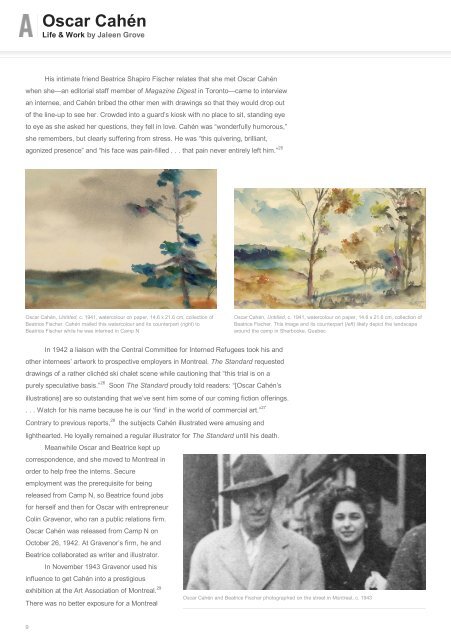Oscar Cahén
Art-Canada-Institute_Oscar-Cah%C3%A9n
Art-Canada-Institute_Oscar-Cah%C3%A9n
You also want an ePaper? Increase the reach of your titles
YUMPU automatically turns print PDFs into web optimized ePapers that Google loves.
<strong>Oscar</strong> <strong>Cahén</strong><br />
Life & Work by Jaleen Grove<br />
His intimate friend Beatrice Shapiro Fischer relates that she met <strong>Oscar</strong> <strong>Cahén</strong><br />
when she—an editorial staff member of Magazine Digest in Toronto—came to interview<br />
an internee, and <strong>Cahén</strong> bribed the other men with drawings so that they would drop out<br />
of the line-up to see her. Crowded into a guard’s kiosk with no place to sit, standing eye<br />
to eye as she asked her questions, they fell in love. <strong>Cahén</strong> was “wonderfully humorous,”<br />
she remembers, but clearly suffering from stress. He was “this quivering, brilliant,<br />
agonized presence” and “his face was pain-filled . . . that pain never entirely left him.”<br />
25<br />
<strong>Oscar</strong> <strong>Cahén</strong>, Untitled, c. 1941, watercolour on paper, 14.6 x 21.6 cm, collection of<br />
Beatrice Fischer. <strong>Cahén</strong> mailed this watercolour and its counterpart (right) to<br />
Beatrice Fischer while he was interned in Camp N<br />
<strong>Oscar</strong> <strong>Cahén</strong>, Untitled, c. 1941, watercolour on paper, 14.6 x 21.6 cm, collection of<br />
Beatrice Fischer. This image and its counterpart (left) likely depict the landscape<br />
around the camp in Sherbooke, Quebec<br />
In 1942 a liaison with the Central Committee for Interned Refugees took his and<br />
other internees’ artwork to prospective employers in Montreal. The Standard requested<br />
drawings of a rather clichéd ski chalet scene while cautioning that “this trial is on a<br />
purely speculative basis.” Soon The Standard proudly told readers: “[<strong>Oscar</strong> <strong>Cahén</strong>’s<br />
illustrations] are so outstanding that we’ve sent him some of our coming fiction offerings.<br />
. . . Watch for his name because he is our ‘find’ in the world of commercial art.”<br />
Contrary to previous reports, the subjects <strong>Cahén</strong> illustrated were amusing and<br />
lighthearted. He loyally remained a regular illustrator for The Standard until his death.<br />
Meanwhile <strong>Oscar</strong> and Beatrice kept up<br />
correspondence, and she moved to Montreal in<br />
order to help free the interns. Secure<br />
employment was the prerequisite for being<br />
released from Camp N, so Beatrice found jobs<br />
for herself and then for <strong>Oscar</strong> with entrepreneur<br />
Colin Gravenor, who ran a public relations firm.<br />
<strong>Oscar</strong> <strong>Cahén</strong> was released from Camp N on<br />
October 26, 1942. At Gravenor’s firm, he and<br />
Beatrice collaborated as writer and illustrator.<br />
In November 1943 Gravenor used his<br />
influence to get <strong>Cahén</strong> into a prestigious<br />
exhibition at the Art Association of Montreal.<br />
There was no better exposure for a Montreal<br />
26<br />
28<br />
29<br />
27<br />
<strong>Oscar</strong> <strong>Cahén</strong> and Beatrice Fischer photographed on the street in Montreal, c. 1943<br />
9



